Surprise! This was the scene at our house yesterday:
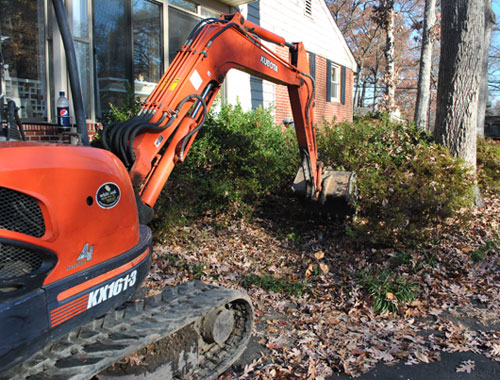
Allow me to explain. We decided to test the soil around our home’s underground oil tank (we have oil heat) a few weeks back to assure any interested buyer that it’s in tip top shape. Much to our horror, it wasn’t. Soil tests came back indicating that we had a small leak. We felt like somebody punched us in the face. Here we are with our rain barrel and our compost bin along with all of our energy star appliances and our cloth diapers in an effort to be green while our oil tank has been oozing nastiness underground without our knowledge. Shudder.
Luckily we learned that it’s something that the Virginia Department of Environmental Quality feels so strongly about fixing that they actually offer a credit to homeowners in our situation, so we only had to pay a $500 deductible for the removal of the old leaky underground tank (and the gross oil-riddled soil around it – hence the excavator pictured above) while the government covers the rest of the usually-around-$2,000 project. Nice right? But we did have to kick in about $1300 to install a new above ground tank (which will never secretly leak since it’ll be visible instead of buried). The good news is that it’s kind of like we’re paying it forward since we’re leaving a new tank for our home’s next owners and our new house actually also just got a new above ground tank (so we’ll inherit one that’s just as new and shiny). Ain’t she pretty all tucked quietly behind our azalea bushes?
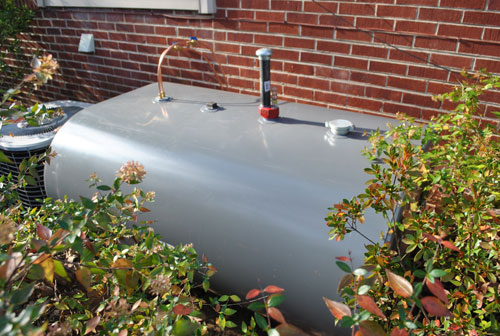
Especially when you compare her to ol’ Rusty. They estimated that our tank was about 30 years old after unearthing it. Here’s hoping 30 is kinder to me when I hit it next year.
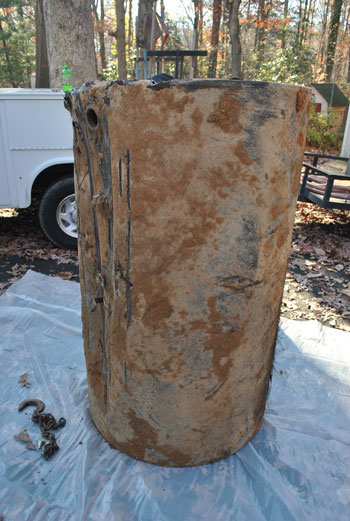
The funny thing is that as gross as that sucker looks, they could only find this dime-sized hole at the bottom (though they said others might be too dirt-clogged to see).
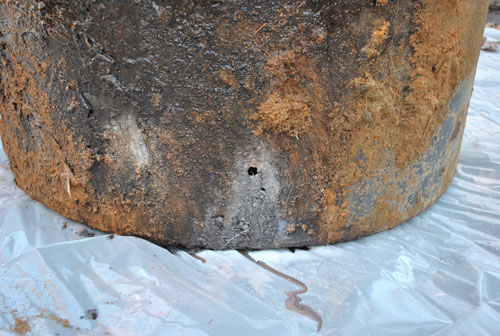
The good news of the whole oil-leakage incident is that since oil doesn’t move very much through compacted dirt like ours, it’s not believed to have traveled very far underground. So the Virginia DEQ just requires the removal of the tank and a bit of surrounding soil to rectify the situation. Okay, maybe a “bit of soil” is an understatement. This was the hole they dug:
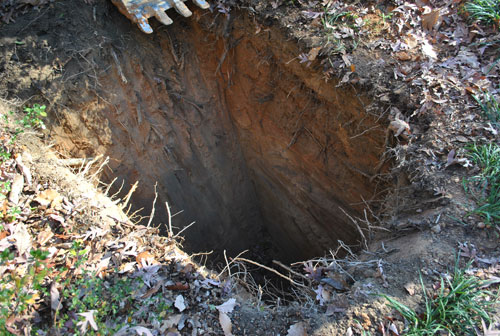
They had to dig up two azalea bushes to make that hole but luckily the process didn’t disturb the driveway or any large trees. And they replanted the pristinely removed azaleas after filling the gorge with gravel and topsoil (though they were the first to say that they make no guarantees about their future survival). Cross your fingers, I guess?
Even though it’s bittersweet to have sunk money into unsinking this leaky tank for our buyers (yay environment, boo spending) we’re definitely comforted by the fact that we’re getting a new shiny tank at our new house (how funny is it that the current owners ran into a similar situation with their underground tank and just upgraded to an above ground version too?). So I guess we could call it good house karma paying off. If you can count following government orders as karma.
Have you guys had oil issues? Or other appallingly ungreen discoveries in general? Nothing like a little unplanned spending around the holidays to get your blood pumping.
Psst- Holy amazingness. Check out this sweet DIY play kitchen that was made from an old TV unit over on BabyCenter.

Paul says
It’s funny to me to read all the “I never heard of oil heat” comments. Natural gas service wasn’t widespread until the 1960s so houses built in the 1950s and earlier tend to have oil heat. At least that is my experience here in Pennsylvania. Having looked at a good number of 1950s houses if the house has a basement tank is usually in there. When they are above ground or buried it is because the house does not have a basement, but is built “on a slab”.
For those looking at a house with oil heat the condition of the tank should be part of the home inspection. We got a new tank out of it b/c the old one was getting rusty. If it’s buried I would make soil testing and any responsibility for repair part of the contract. I applaud YHL for taking this responsibility on of their own volition.
Stephanie says
We just bought a house and scanned for an underground oil tank and thankfully there wasn’t one there as we were told by the inspector that it could cost well over $10,000 to remove! So $500 definitely wasn’t a bad price to pay :)
Krista G. says
S and J, I feel your pain! Last year we were at a point where we were under contract, after having the first TWO offers fall through at the last minute! The first two inspections came through fine, but the last inspection revealed a problem with the septic system. $3000 we weren’t expecting to spend at the 11th hour. But, we are now in another great house with many projects to do…
Laura says
Glad it worked out! I hadn’t even heard of oil heat or baseboard heat until I moved out East. I was so shocked that people use oil and coal out here. Coming from the Pac NW, we were used to natural gas and hydro-electric power and all things earth friendly. I’ve been cursing at our utility bills ever since moving!
Natalia Beley says
We had to deal with the same thing when we sold our older house in NJ. Our small front yard had to get dug up and we had to wait over a year for the NJDEP to say that everything was OK so the buyers held some of our money in escrow for that whole time! Not fun. We learned our lesson after that and didn’t buy another house with an underground oil tank. I’m glad yours seemed pretty painless. I hope the rest of your move goes smoothly!
Ronda says
Sherry, I read what you wrote above about being able to smell when there’s a leak, and I agree, HOWEVER…
If you or your oil provider are not using fuel additives like Heat or “Hot 4-in-1” to keep water out, you may come home one day to the smell of 200 gallons of oil. Everywhere.
Tanks that aren’t treated with fuel additives store any condensation at the BOTTOM of the tank; it sinks to the bottom because it’s heavier than the oil. It sits there, corroding your tank from the inside out. And then one day, it simply starts falling apart. Hopefully it won’t happen to you; but it happened to me. I try to warn people when the chance presents itself.
YoungHouseLove says
Thanks so much for that info Ronda! So good to know! We’ll be sure they’re using a fuel additive to keep that issue from happening down the line!
xo,
s
carrye says
Not sure if anyone has mentioned this yet, but one thing I will be sure to do is have the entire plumbing system scoped with a camera before I buy any house in the future (especially an older one). This isn’t a normal part of most inspections unfortunately. The 50+ year old brick house we bought last year has cast iron pipes and they are starting to rust out in places. It was kind of cool to watch while they scoped through the pipes–at least I could see for myself how bad off they were. We have to replace our entire system which will cost us anywhere from $7k to $13k! Luckily our house is only 1100 sq ft, or it would be much worse. Merry Christmas to us! :)
Jennifer says
Yeah! I knew I read this at some point! Not only are we looking to rewire but the second biggest issue is the oil tank. I was looking for your “true cost” versus, what I keep reading as it could be this or that or or or. I will keep you posted! We were referred to Pollard. Do you mind sharing yours? You can email me seperately, if time allows! TIA
YoungHouseLove says
Pollard was ours too!
xo,
s
Jeffro says
I’m on a campaign to tell EVERYONE who has a buried tank to get it OUT OF THE GROUND, NOW! Don’t let this happen to you!
http://s224.photobucket.com/albums/dd118/JeffPicks/Oil%20Tank%20Remediation/
The cost to the homeowner for this remediation was nearly nothing due to having ‘insurance’. The bills to the insurance company totaled around $250,000.00
Don’t delay! The longer you wait, the worse it gets!
Willson Brockenbrough says
A different angle to consider – our son, then about 7 yrs. old – had a build-up of lead, arsenic, mercury and beryllium in his blood when we had him tested for neurological issues. Pondering in the middle of the night, as a worried dad is prone to do, I googled oil burners to find out what they emit, since our first floor walls and windows showed evidence of oil heat. What are the byproducts? You guessed it – lead, arsenic, mercury, cadmium, beryllium and other trace metals.
We had our fairly new oil tank dug up and properly disposed of, the boiler carted off and a more environmentally-friendly modulating, high-efficiency, wall-hung boiler installed, which saved us about 40% on our oil bill the first year, works like a champ and eliminates one of the many things I worry about in my new role (plus we abandoned that flue which needed relining anyway).